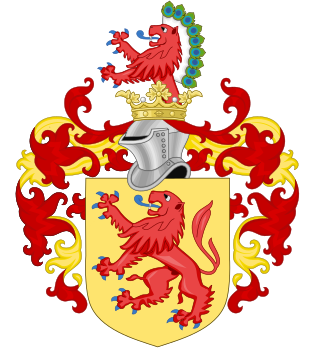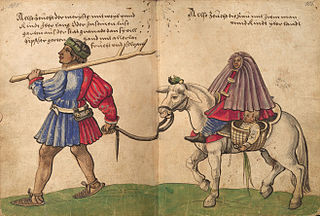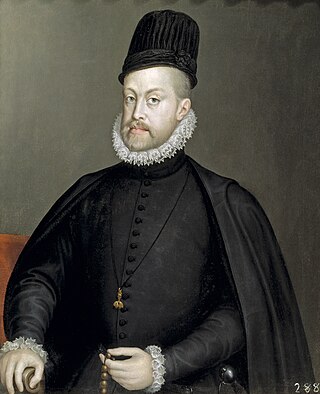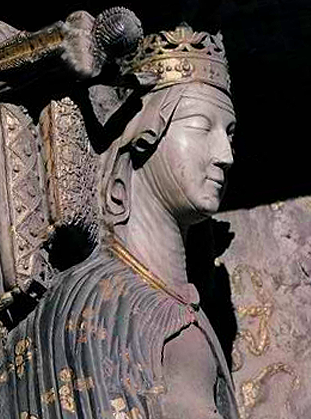
The House of Habsburg, also known as the House of Austria, is one of the most prominent and important dynasties in European history.

The 1490s decade ran from January 1, 1490, to December 31, 1499.
The 1380s was a decade of the Julian Calendar which began on January 1, 1380, and ended on December 31, 1389.
Year 1495 (MCDXCV) was a common year starting on Thursday of the Julian calendar.

Year 1501 (MDI) was a common year starting on Friday in the Julian calendar.

Ferdinand is a Germanic name composed of the elements farð "journey, travel", Proto-Germanic *farthi, abstract noun from root *far- "to fare, travel", and nanth "courage" or nand "ready, prepared" related to Old High German nendan "to risk, venture."

Year 1470 (MCDLXX) was a common year starting on Monday of the Julian calendar.

Philip II, also known as Philip the Prudent, was King of Spain from 1556, King of Portugal from 1580, and King of Naples and Sicily from 1554 until his death in 1598. He was also jure uxoris King of England and Ireland from his marriage to Queen Mary I in 1554 until her death in 1558. He was also Duke of Milan from 1540. From 1555, he was Lord of the Seventeen Provinces of the Netherlands.

The House of Hanover is a European royal house with roots tracing back to the 17th century. Its members, known as Hanoverians, ruled Hanover, Great Britain, Ireland, and the British Empire at various times during the 17th to 20th centuries. Originating as a cadet branch of the House of Welf in 1635, also known then as the House of Brunswick-Lüneburg, the Hanoverians ascended to prominence with Hanover's elevation to an Electorate in 1692. In 1714 George I, prince-elector of Hanover and a descendant of King James VI and I, assumed the throne of Great Britain and Ireland, marking the beginning of Hanoverian rule over the British Empire. At the end of his line, Queen Victoria's death in 1901, the throne of the United Kingdom passed to her eldest son Edward VII, a member of the House of Saxe-Coburg and Gotha, through his father Albert, Prince Consort. The last reigning members of the House of Hanover lost the Duchy of Brunswick in 1918 when Germany became a republic.

Charles, Prince of Viana, sometimes called Charles IV of Navarre, was the son of King John II of Aragon and Queen Blanche I of Navarre.
A personal union is a combination of two or more monarchical states that have the same monarch while their boundaries, laws, and interests remain distinct. A real union, by contrast, involves the constituent states being to some extent interlinked, such as by sharing some limited governmental institutions. Unlike a personal union, in a federation or a unitary state, a central (federal) government spanning all member states exists, with the degree of self-governance distinguishing the two. The ruler in a personal union does not need to be a hereditary monarch.

Catherine of Lancaster was Queen of Castile by marriage to King Henry III of Castile. She governed Castile as regent from 1406 until 1418 during the minority of her son.

Eleanor of Aragon was Queen of Portugal from 1433 to 1438 as the spouse of King Edward. After Edward's death, she served as regent in 1438-1440 for her son Afonso V. She was the daughter of Ferdinand I of Aragon and Eleanor of Alburquerque.
Joanna of Aragon was Queen of Naples as the second wife of King Ferdinand I. She served as regent of Naples between the abdication and flight of her husband's son Alfonso II on 22 February 1495 until the formal succession of Alfonso's son, Ferdinand II.

Ferdinand II was King of Aragon from 1479 until his death in 1516. As the husband and co-ruler of Queen Isabella I of Castile, he was also King of Castile from 1475 to 1504. He reigned jointly with Isabella over a dynastically unified Spain; together they are known as the Catholic Monarchs. Ferdinand is considered the de facto first king of Spain, and was described as such during his reign, even though, legally, Castile and Aragon remained two separate kingdoms until they were formally united by the Nueva Planta decrees issued between 1707 and 1716.
Galceran de Requesens y Santa Coloma, a Catalan nobleman, was an enemy of the Barcelona city council, and was Governor of Mallorca. He was a son of Luis de Requesens y Relat, baron of Altafulla and La Nou de Gaià, both rural lands located in the Spanish province of Tarragona.
Domenec Ram y Lanaja was an aragonese politician and diplomat who was Viceroy of Sicily in 1415–1419, succeeding Prince John of Aragon, later King John II of Aragon.

Infante Henry of Aragon, 1st Duke of Villena, 3rd Count of Alburquerque, Count of Ampurias, was the Grand Master of the Order of Santiago.